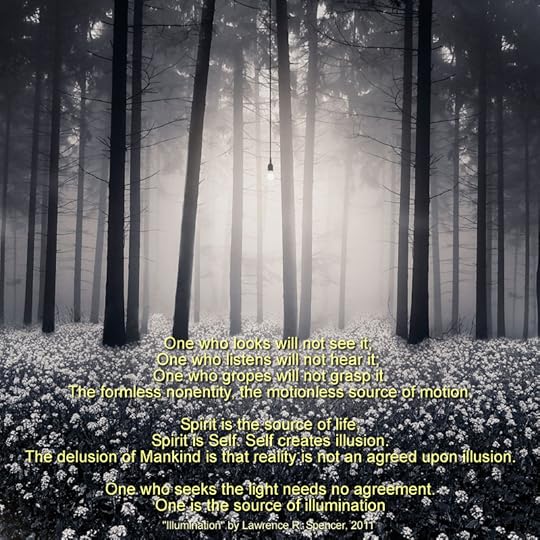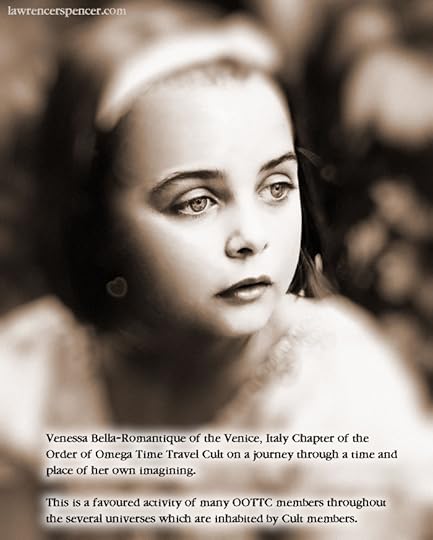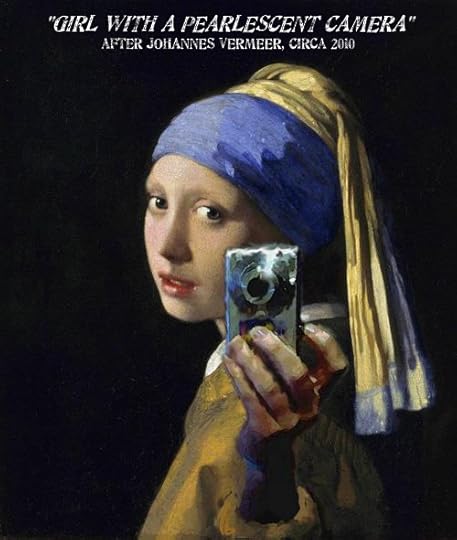Lawrence R. Spencer's Blog, page 348
August 17, 2018
VISION
“Your vision will become clear only when you can look into your own heart. Who looks outside dreams. Who looks inside awakes.”
— Carl Jung —
Originally posted 2013-10-02 11:51:10. Republished by Blog Post Promoter
August 16, 2018
ILLUNINATION
August 15, 2018
PALINGENESIS
Originally posted 2015-12-23 03:52:49. Republished by Blog Post Promoter
August 14, 2018
LIFE RUSHES FROM WITHIN

(painting by Michael Parkes)
“She used to drag her mattress beside her low window and lie awake for a long while, vibrating with excitement, as a machine vibrates from speed. Life rushed in upon her through that window – or so it seemed. In reality, of course, life rushes from within, not from without.”
_________________________________
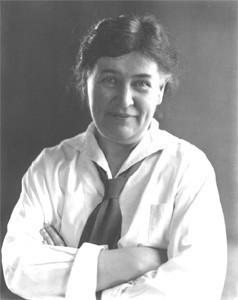 – Willa Cather (1873-1947), American author and teacher, considered to be one of the best chroniclers of pioneering life in the 20th century wrote My Ántonia (1918).
– Willa Cather (1873-1947), American author and teacher, considered to be one of the best chroniclers of pioneering life in the 20th century wrote My Ántonia (1918).
“No romantic novel ever written in America, by man or woman, is one half so beautiful as My Antonia.” In this symphonically powerful and magnificently observed novel, Willa Cather created one of the most winning heroines in American fiction, a woman whose robust high spirits and calm, undemonstrative strength make her emblematic of the virtues Cather most admired in her country. We first meet Antonia Shimerda as the young daughter of a Bohemian immigrant who in time will be driven to suicide by the oceanic loneliness of life on the Nebraska prairie. Through the eyes of Jim Burden, her tutor and disappointed admirer, we follow Antonia from farm to town and through hardships both natural and human, surviving everything from poverty to a failed romance– and not only surviving, but triumphing.
READ THE BOOK “My Antonia” on-line: http://www.online-literature.com/willa-cather/my-antonia/
VISIT THE WILLA CATHER Foundation Website: www.willacather.org/
Originally posted 2013-02-12 15:25:33. Republished by Blog Post Promoter
August 13, 2018
IT DOESN’T END HERE
“End? No, it doesn’t end here. Death is just a new path, a path everyone has to take. Many that live deserve death. And some that die deserve life. Can you give it to them? Then do not be too eager to deal out death in judgment. For even the very wise cannot see all ends.”
Originally posted 2012-12-03 23:40:37. Republished by Blog Post Promoter
STOP BEING HUMAN!
August 11, 2018
DREAM TRAVEL
(Photo credit: TheBlue26 on Flickr)
Originally posted 2011-12-21 00:14:52. Republished by Blog Post Promoter
August 10, 2018
Recasting The Girl, Spray-Painting The Pearl
I will not soon forget seeing the horrendous Hollywood movie titled, “The Girl With A Pearl Earring” in 2004. It is a fictional depiction of a fictionalized relationship between Vermeer and an imagined “…young peasant maid working in the house of painter Johannes Vermeer becomes his talented assistant and the model for one of his most famous works.” It was nominated for 3 Oscars by the Academy of Motion Picture “arts” and “sciences”.
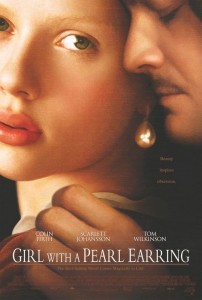 This tragically tacky spin on the life of Vermeer is classic Hollywood magic: take the true life story of a teen-age daughter of one of the finest painters in history, re-cast her as whore, and her father as an brutish ogre, spray-paint her naturally luminescent pearl earring with glitter glue and, presto! Nominate it for an Oscar!
This tragically tacky spin on the life of Vermeer is classic Hollywood magic: take the true life story of a teen-age daughter of one of the finest painters in history, re-cast her as whore, and her father as an brutish ogre, spray-paint her naturally luminescent pearl earring with glitter glue and, presto! Nominate it for an Oscar!
Absurdly cliché characterizations contrived by the brain-dead writers invent a debased relationship between a fictional “peasant maid” and Vermeer that are typical of the money-motivated Hollywood swill fed to and gobbled up by an uneducated public. The socially redeeming value of this food for swine (to be polite) is a pile of steaming shit! Sexual intrigue may sell movie tickets, but pigs are stupid, and shit stinks.
The writers, producers and actors associated with this morose movie would have been more kind to Vermeer, his family and his artistic legacy if they had spent the budget for the film to visit the museums of the world, in which his priceless works hang, and spray them with graphic graffiti.
The film was written and directed without regard for historic fact or common sense. The preposterous personae of Vermeer was portrayed by the British actor, Colin Firth, with the charisma of a cardboard cereal box. Scarlett Johansson, who plays the role of the gawkish “girl”, is garish at best.
The premise of the ludicrous book and movie script, entirely ignores and abuses the obvious, and thoroughly researched historical information about Vermeer and his life. A few of the grossest omissions are:
1) All of the women in the Vermeer paintings, with one or two minor exceptions, are his wife, and daughters. To postulate that he hired a “peasant maid”, or that he had a painting assistant, much less that he had a sexual relationship with such an imaginary person, are sick contrivances.
2) That the Vermeers could afford to pay a servant, who could spare the time away from vitally needed chores, to become an artists assistant, is blatantly stupid. Household helpers were not something they could afford, except early in their marriage, at best. Some of the thoroughly researched facts about Vermeer were that he and his wife produced 15 children in 22 years! They lived in the small village of Delft, with his wife’s very Catholic mother, in her small house, to help reduce expenses. He died from overwhelming depression due to his inability to support his wife and 11 surviving children, who were left in extreme poverty at his premature death at the age of 43.
In a plea to her creditors after her husband’s death Catharina stated, in the public record, the final footnotes to Vermeer’s brief life:
“during the ruinous war he not only was unable to sell any of his art but also, to his great detriment, was left sitting with the paintings of other masters that he was dealing in.”
Catharina summarized the circumstances of his death: “as a result and owing to the great burden of his children, having no means of his own, he had lapsed into such decay and decadence, which he had so taken to heart that, as if he had fallen into a frenzy, in a day or day and a half had gone from being healthy to being dead.”
Obviously, the man she describes is the antithesis of the man portrayed in the movie.
3) That a woman would be allowed to become an artists apprentice or assistant, is an absurd fantasy. It was forbidden by the Guild of St. Luke which maintained strict, Puritanical oversight of the activities of every member.
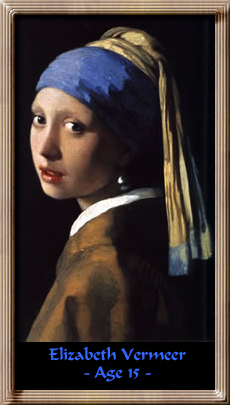 4) The girl in the legendary painting (as well as in several other of his paintings) is his second daughter, Elizabeth! Vermeer never hired models — he painted only family and friends. It doesn’t take a cosmetic surgeon to compare the features of the women in the majority of his paintings to observe that the same women are being painted in their own home, again and again in different poses, settings, lighting and clothing. Most of his paintings feature his wife, Catharina, who was not only his constant accomplice in creating a family, she was his foremost ally in his life as an artist!
4) The girl in the legendary painting (as well as in several other of his paintings) is his second daughter, Elizabeth! Vermeer never hired models — he painted only family and friends. It doesn’t take a cosmetic surgeon to compare the features of the women in the majority of his paintings to observe that the same women are being painted in their own home, again and again in different poses, settings, lighting and clothing. Most of his paintings feature his wife, Catharina, who was not only his constant accomplice in creating a family, she was his foremost ally in his life as an artist!
The paintings named (by others), “girl with a pearl earring”, as well as “the girl with a red hat”, and “the girl with a flute”, and others, are all of his second daughter, Elizabeth, who was a teenager when they were painted. He used her as the model for a series of very small “tronie” or facial portraits, which were popular at the time.
These miniature “head shots” were especially well suited to the use of the camera obscura to create what we know now to have a photographic quality, rendering the light and perspective differently than the unaided lens of the human eye perceives it.
The women in his family, during his lifetime, enjoyed dressing in the finest clothes and jewelry available to them, as well as exotic costumes, imitating the apparel of mysterious lands. Many of the accessories included in these paintings were borrowed. Trading vessels often brought fascinated news and relics to Delft from around the world. He and his family rarely ventured more than a short walk or boat ride from home.
That Vermeer would have an elicit affair with a maid in his own home is an insult to common sense and decency. Anyone who looks at paintings of his wife and nine daughters can plainly see his obvious love and devotion — if not obsession — for the women in the small house they shared. Vermeer’s family permeated every aspect of his life, and dominated his home.
His days were consumed with his work with the Guild of St. Luke, the militia of Delft, and interaction with other painters for whom, like his father before him, he sold their paintings to earn money to feed and clothe his 15 children. As his family grew, Vermeer barely had time work on his own paintings!
That there was ever any enmity or discord between Johannes and Catharina during their lives is a fantasy contrived by the Hollywood money machine that perverts reality to appeal to the lowest common denominator of prurient interest suitable only for soap operas, pornography, and girl-gossip magazines.
The self-proclaimed “artists” of Hollywood, driven by money mongers, like any mindless mercenary who act the part they’re paid for, notoriously devoid of ethics or integrity, are akin to any common soldier who massacres innocent civilians, and justifies their crimes in the name of war.
Vermeer, in this movie, and in his own lifetime, was a victim of brainless brutality. The stupid soldiers of Louis XIV of France who invaded Holland, together with the bloody British aristocracy combined to murder peasants, and plunder goods to enrich and glorify themselves. The net result for Vermeer was attested, after his death, by his wife, Catharina Bolnes, “during the ruinous war he not only was unable to sell any of his art but also, to his great detriment, was left sitting with the paintings of other masters that he was dealing in.” And further, “as a result and owing to the great burden of his children, having no means of his own, he had lapsed into such decay and decadence, which he had so taken to heart that, as if he had fallen into a frenzy, in a day or day and a half had gone from being healthy to being dead.”
Let us hope, sincerely, that those unfortunates who saw this “ruinous movie” can assess for themselves the denigrating massacre of an artist by Hollywood, compared with his own biographical portraits of a lifetime and the family he adored, magnificently embodied in his paintings, to judge for themselves the aesthetic intention and ethical integrity of the man, Vermeer.
— Lawrence R. Spencer
Originally posted 2009-09-11 22:48:38. Republished by Blog Post Promoter
August 7, 2018
GIRL WITH A PEARLESCENT CAMERA
This picture is a modern spoof on the world famous painting by the 16th century Dutch artist Johannes Vermeer. The girl in the legendary painting (as well as in several other of his paintings) is his second daughter, Elizabeth! Vermeer never hired models — he painted only family and friends. It doesn’t take a cosmetic surgeon to compare the features of the women in the majority of his paintings to observe that the same women are being painted in their own home, again and again in different poses, settings, lighting and clothing. Most of his paintings feature his wife, Catharina, who was not only his constant accomplice in creating a family, she was his foremost ally in his life as an artist!
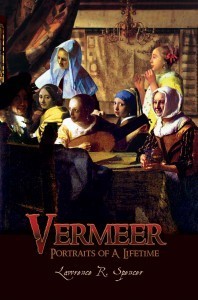
The painting named (by others), “Girl with a pearl earring”, as well as “The girl with a red hat”, and “The girl with a flute”, and others, are all of his second daughter, Elizabeth, who was a teenager when they were painted. He used her as the model for a series of very small “tronie” or facial portraits, which were popular at the time.
These miniature “head shots” were especially well suited to the use of the camera obscura to create what we know now to have a photographic quality, rendering the light and perspective differently than the unaided lens of the human eye perceives it.
To learn all of the details about the women who posed for Johannes Vermeer in all of his famous paintings, read the book VERMEER: PORTRAITS OF A LIFETIME, by Lawrence R. Spencer.
DOWNLOAD THIS BOOK FROM iTUNES
http://itunes.apple.com/us/book/vermeer/id443800993?mt=11
Originally posted 2012-04-04 11:34:23. Republished by Blog Post Promoter
August 6, 2018
DO WHAT THOU WILT

(Image by Marianna Stelmach)
____________________________
François Rabelais (c. 1494 – 9 April 1553) was a major French Renaissance writer, doctor, Renaissance humanist, monk and Greek scholar. He has historically been regarded as a writer of fantasy, satire, the grotesque, bawdy jokes and songs. His best known work is Gargantua and Pantagruel. Rabelais is considered one of the great writers of world literature and among the creators of modern European writing.
____________________________________________
“All their life was spent not in laws, statutes, or rules, but according to their own free will and pleasure. They rose out of their beds when they thought good; they did eat, drink, labour, sleep, when they had a mind to it and were disposed for it. None did awake them, none did offer to constrain them to eat, drink, nor to do any other thing; for so had Gargantua established it. In all their rule and strictest tie of their order there was but this one clause to be observed, “Do What Thou Wilt;” because men that are free, well-born, well-bred, and conversant in honest companies, have naturally an instinct and spur that prompteth them unto virtuous actions, and withdraws them from vice, which is called honour. Those same men, when by base subjection and constraint they are brought under and kept down, turn aside from that noble disposition by which they formerly were inclined to virtue, to shake off and break that bond of servitude wherein they are so tyrannously enslaved; for it is agreeable with the nature of man to long after things forbidden and to desire what is denied us.”
— Rabelais, description of how the Thélèmites lived and the rules they lived by.
Originally posted 2013-01-24 11:07:44. Republished by Blog Post Promoter


